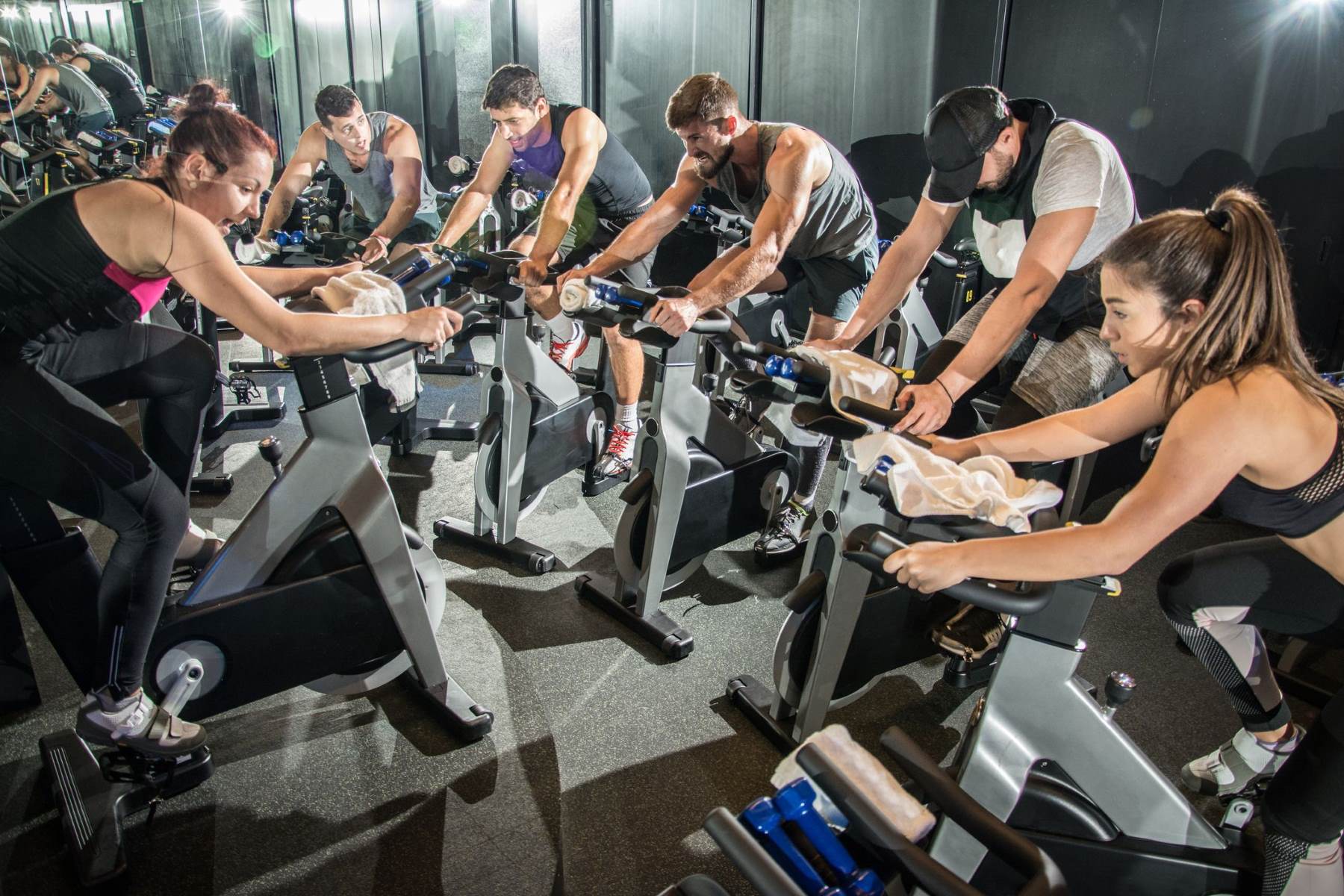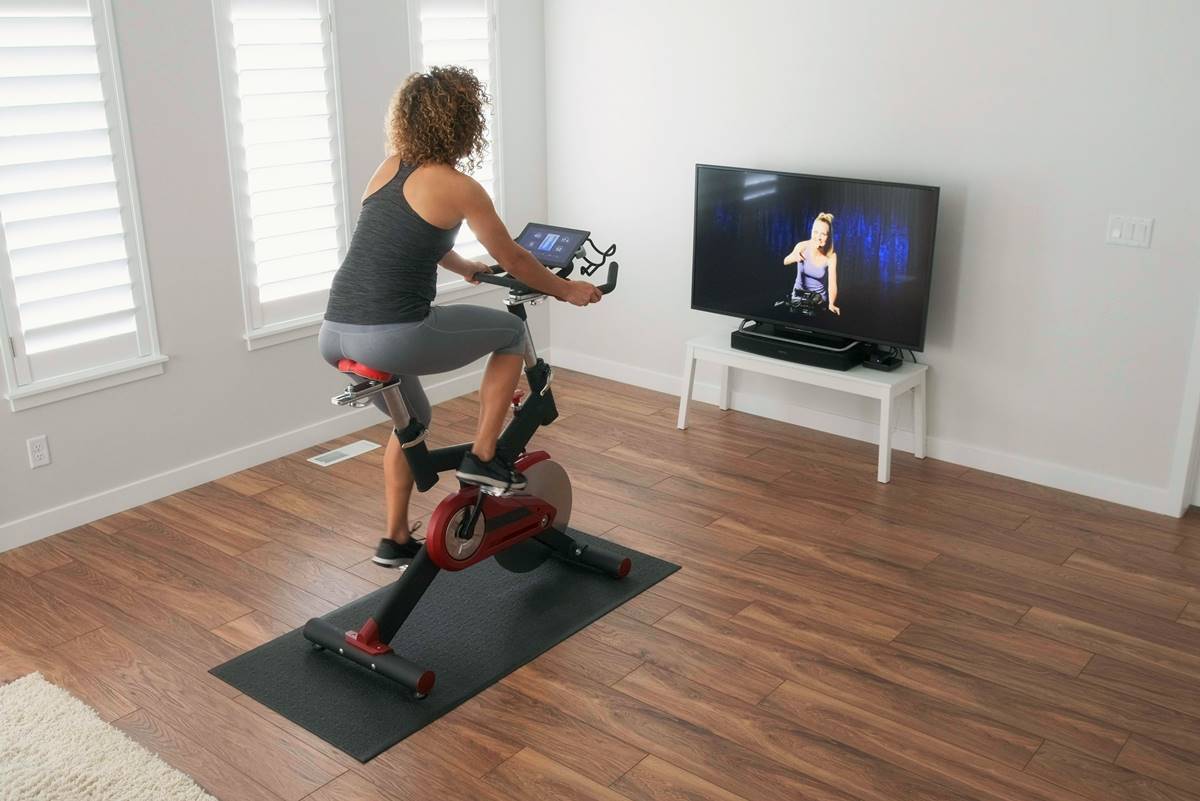

Featured
What Is Spinning Workout
Modified: March 2, 2024
Learn all about the featured spinning workout and how it can help you achieve your fitness goals. Discover the benefits and techniques of this popular fitness class.
Introduction
Welcome to the world of spinning workouts! If you’re looking for an intense, calorie-burning, and impactful exercise routine, spinning might be just what you need. Spinning, also known as indoor cycling, has gained immense popularity over the years as a form of cardiovascular exercise that can help you shed those extra pounds, improve your fitness level, and boost your overall well-being.
Spinning workouts are not only a great way to get your heart pumping and your legs burning, but they also provide a fun and engaging group exercise experience. Whether you’re a beginner or an experienced fitness enthusiast, spinning workouts offer a low-impact, high-energy activity suitable for people of all fitness levels.
During a spinning workout, you’ll be placed on a stationary bike and guided through a series of simulated terrains, including hills, sprints, and endurance drills. These workouts are usually led by a certified instructor who will motivate and challenge you throughout the session.
In this article, we’ll delve into the details of spinning workouts, exploring their benefits, how they work, how to set up your spinning bike, different workout routines, safety tips, and frequently asked questions. By the end, you’ll have a comprehensive understanding of spinning workouts and the tools you need to start incorporating them into your fitness routine.
Whether your goal is to lose weight, improve your cardiovascular endurance, or simply have a blast while getting fit, spinning workouts offer a dynamic and effective solution. So, let’s dive in and discover the exciting world of spinning workouts!
What is Spinning Workout?
Spinning workouts, also known as indoor cycling, are a form of exercise that involves riding a stationary bike in a group setting or at home. Originating in the 1990s, spinning workouts have become increasingly popular due to their high-intensity nature and numerous health benefits.
Unlike outdoor cycling, spinning workouts take place indoors on specially designed stationary bikes. These bikes have adjustable resistance levels, allowing participants to simulate various terrains, such as flat roads, hills, and sprints. The workout is typically led by a certified instructor who guides participants through a series of exercises, accompanied by motivating music to keep the energy levels high.
One of the key benefits of spinning workouts is the ability to burn a significant number of calories in a short period of time. Depending on the intensity of the workout and individual factors, such as weight and fitness level, participants can burn upwards of 400-600 calories in a 45-minute session. This makes spinning an excellent choice for individuals looking to lose weight or improve their overall fitness.
Aside from calorie burn, spinning workouts offer a range of other benefits. One of the main advantages is cardiovascular endurance. By engaging in these high-intensity workouts, participants can improve their heart and lung health, as well as increase their cardiovascular fitness. Regular spinning sessions can lead to increased stamina and endurance, allowing individuals to perform better in other physical activities.
In addition to cardiovascular benefits, spinning workouts also target various muscle groups. The lower body, including the quadriceps, hamstrings, calves, and glutes, are particularly engaged during cycling movements. This not only helps to strengthen and tone these muscles but also improves overall leg strength and stability.
Furthermore, spinning workouts provide a low-impact exercise option, making it suitable for individuals of all fitness levels. The stationary bike reduces impact on the joints, making it a good choice for those with joint issues or injuries. At the same time, the adjustable resistance levels allow participants to customize the intensity of the workout to their individual capabilities.
Overall, spinning workouts offer a challenging and effective form of exercise that can improve cardiovascular fitness, burn calories, and strengthen the lower body. With the guidance of a certified instructor and engaging music, spinning workouts provide a fun and energetic group exercise experience that keeps people motivated and coming back for more.
Benefits of Spinning Workout
Spinning workouts offer a multitude of benefits for both your physical and mental well-being. From improving cardiovascular health to boosting mood, here are some key advantages of incorporating spinning into your fitness routine:
- Cardiovascular endurance: Spinning workouts are excellent for improving cardiovascular endurance. As you pedal through various resistance levels and simulated terrains, your heart rate increases, strengthening your heart and lungs. Over time, this leads to improved aerobic capacity and better overall cardiovascular health.
- Calorie burn: Spinning is a highly effective calorie-burning exercise. In just a 45-minute session, you can burn anywhere from 400 to 600 calories, depending on your intensity level and body weight. Regular spinning workouts can help you maintain a healthy weight or aid in weight loss.
- Leg strength and toning: Spinning primarily targets the muscles in your legs, including the quadriceps, hamstrings, calves, and glutes. The continuous pedaling motion helps to build strength and tone these muscles, giving you lean and sculpted legs.
- Low-impact exercise: Unlike activities such as running or jumping, spinning is a low-impact exercise that puts minimal stress on your joints. This makes it an ideal choice for individuals with joint issues or injuries, as it reduces the risk of impact-related discomfort or further injury.
- Mental well-being: During a spinning workout, your body releases endorphins, which are natural mood boosters. These endorphins help reduce stress, anxiety, and depression, leaving you feeling more energized and mentally refreshed after each session.
- Improved core strength: While the focus is primarily on the legs during spinning, engaging your core muscles is essential for maintaining stability and proper form. Regular spinning workouts can help strengthen your abdominal muscles and improve overall core strength and stability.
- Flexibility and joint mobility: As you pedal and move through various positions on the bike, you’ll improve your joint flexibility and range of motion. This can help prevent stiffness and improve overall joint mobility, making everyday activities easier.
- Group exercise experience: Spinning workouts are often done in a group setting, which can provide an extra motivation boost. Exercising alongside others with an instructor leading the class creates a fun and supportive environment that keeps you motivated throughout the workout.
Whether you’re looking to boost your cardiovascular health, burn calories, strengthen your legs, or simply enjoy a group exercise experience, spinning workouts offer a wide range of physical and mental benefits. Incorporating spinning into your fitness routine can lead to improved overall well-being and a healthier, more active lifestyle.
How does Spinning Workout Work?
Spinning workouts are designed to mimic the experience of outdoor cycling while providing a controlled and high-intensity workout environment. These workouts typically take place on stationary bikes that allow participants to adjust the resistance levels to simulate different terrains.
The main components of a spinning workout include duration, intensity, and variations in resistance levels. The instructor will guide the class through a series of exercises, incorporating techniques such as sprints, climbs, and intervals to provide a challenging and effective workout.
The instructor sets the tempo and intensity of the workout by selecting suitable music and providing cues for speed and resistance changes. The class may involve a combination of seated and standing positions, as well as the use of hand weights for additional upper body engagement during certain routines.
During a spinning workout, participants aim to maintain a target heart rate range to achieve cardiovascular benefits. The intensity can be adjusted by modifying the resistance on the bike. Increasing the resistance level simulates climbing or riding on an incline, requiring more effort and energy expenditure. Lowering the resistance allows for a faster pedaling speed, simulating flats or downhill terrains.
Spinning workouts typically follow a structured format, starting with a warm-up to prepare the body for exercise. The warm-up is followed by a combination of sprints, climbs, intervals, and recovery periods. The class may also incorporate timed drills or specific techniques to challenge different muscle groups and energy systems.
Throughout the workout, the instructor motivates and encourages participants to push themselves, maintain proper form, and find their rhythm. This creates a dynamic and engaging environment that keeps participants motivated to achieve their fitness goals.
The duration of a spinning workout can vary, typically ranging from 30 to 60 minutes. The intensity levels and duration will depend on the individual’s fitness level and goals. Beginners may start with shorter sessions at lower intensities and gradually increase the duration and intensity as they build their cardiovascular endurance and strength.
It’s important to note that spinning workouts can be modified to accommodate different fitness levels. Participants are encouraged to listen to their bodies, adjust the resistance and speed as needed, and take breaks when necessary. The focus should be on maintaining proper form, breathing rhythmically, and challenging yourself within your own capabilities.
Overall, spinning workouts are an effective combination of cardiovascular exercise, strength training, and motivation. By simulating outdoor cycling in a controlled environment, spinning workouts provide a challenging and dynamic workout suitable for individuals of all fitness levels.
Setting up Your Spinning Bike
Before you begin your spinning workout, it’s important to properly set up your stationary bike to ensure a safe and comfortable exercise experience. Here are some key steps to follow when setting up your spinning bike:
- Adjust the seat height: Start by standing next to the bike and adjusting the seat height so that it aligns with your hip bone. When you sit on the bike, your legs should have a slight bend at the knees when the pedals are at the lowest point.
- Position the seat forward or backward: Move the seat forward or backward to find a comfortable position that allows your knees to line up with your feet when the pedals are parallel to the floor. This position helps ensure proper alignment and reduces the risk of strain or injury.
- Set the handlebar height: The handlebars should be adjusted to a height that allows you to maintain a comfortable and relaxed grip. It’s important to avoid excessive leaning or hunching over the handlebars, as this can place strain on your neck, shoulders, and back.
- Check the distance between the seat and handlebars: The distance between the seat and handlebars should be adjusted so that you can maintain a slight bend at the elbows when your hands are on the handlebars. This ensures proper posture and minimizes stress on your upper body.
- Secure your feet: Make sure your feet are securely positioned on the pedals. Most spinning bikes have adjustable straps or cages to hold your feet in place. Ensure the straps are snug but not too tight, allowing your feet to move naturally during pedaling.
- Test the bike: Before starting your workout, take a few moments to pedal and make any necessary adjustments. Ensure that the bike feels stable and that all components are functioning properly.
It’s worth noting that every individual may have slightly different preferences when it comes to bike setup. Experiment with the positioning to find what feels most comfortable and allows you to maintain proper form throughout your workout.
Remember, proper bike setup is essential for preventing injuries and ensuring an effective and enjoyable spinning workout. Take the time to adjust your bike according to your body’s dimensions and comfort level, and don’t hesitate to seek assistance from a certified instructor or gym staff if needed.
Basic Spinning Workout Routine
A basic spinning workout routine typically consists of several phases and exercises designed to challenge your cardiovascular endurance and strengthen your lower body. Here’s an example of a basic spinning workout routine:
- Warm-up: Begin your workout with a 5-10 minute warm-up at a comfortable pace. Pedal on a flat terrain with low resistance to gradually increase your heart rate and warm up your muscles.
- Sprints: After the warm-up, incorporate sprints into your workout routine. Increase the resistance and pedal at a fast pace for 30 seconds to 1 minute, then recover for 1-2 minutes at an easy pace. Repeat this sprint and recovery cycle for several rounds to challenge your cardiovascular system.
- Hill climbs: Increase the resistance to simulate uphill climbs. Start with a moderate resistance and gradually increase it as you go. Maintain a steady and consistent effort as though you are climbing a hill. Incorporate standing climbs to engage different muscle groups and vary the intensity of the workout.
- Seated endurance: Return to a seated position and pedal at a moderate pace for an extended period of time, usually 5-10 minutes. This endurance phase helps build stamina and improves your cardiovascular fitness.
- Interval training: Alternate between periods of high-intensity effort and recovery. Increase the resistance and pedal at a challenging pace for a set time, such as 1-2 minutes, then reduce the resistance and recover for an equal or slightly longer period. Repeat these intervals for several cycles to improve your aerobic capacity and burn calories.
- Cool-down: Finish your workout with a 5-10 minute cool-down, gradually decreasing the intensity and resistance. Pedal at a comfortable pace to lower your heart rate and allow your muscles to recover.
Remember, this is just a basic spinning workout routine, and you can modify it to suit your fitness level and preferences. If you’re a beginner, start with shorter durations and lower intensities, gradually increasing as your fitness improves. For more advanced participants, you can add variations, such as jumps, seated accelerations, or advanced climbing techniques.
It’s important to listen to your body and adjust the resistance and pace according to your comfort level. Stay hydrated throughout the workout, and don’t forget to breathe deeply and engage your core muscles to maintain proper form and maximize the benefits of your spinning workout.
Advanced Spinning Workout Techniques
If you’re ready to take your spinning workouts to the next level, incorporating advanced techniques can help you challenge your limits and maximize your results. Here are some advanced spinning workout techniques to consider:
- Interval variations: Instead of sticking to fixed intervals, try incorporating varying interval lengths and intensities into your workouts. For example, alternate between short bursts of high-intensity sprints and longer intervals of moderate to high resistance endurance rides. This variation keeps your body guessing and prevents plateauing.
- Plyometrics: Integrate plyometric exercises into your spinning routine to boost your explosive power and strengthen your legs. During seated or standing climbs, add power jumps, where you briefly lift off the seat and jump with both feet, returning to the seat as you land. These explosive movements engage your lower body muscles and elevate your heart rate.
- Tabata drills: Tabata training is a high-intensity interval training (HIIT) method that involves 20 seconds of all-out effort followed by 10 seconds of rest, repeated for four minutes. Incorporate Tabata drills into your spinning workouts by selecting a challenging resistance level and pedaling at maximum effort for 20 seconds, followed by 10 seconds of recovery. Repeat this cycle for multiple rounds.
- Power climbs: During your hill climb segments, add more resistance and focus on increasing your power output. Shift into a heavier gear and maintain a controlled but powerful pedal stroke. Emphasize the upward pull on the pedals to engage your hamstrings and glutes. Power climbs are an effective way to build strength and muscular endurance.
- Cadence variations: Experiment with different cadences (pedaling speeds) during your workouts. Incorporate sections where you pedal at a faster cadence, aiming for 100+ revolutions per minute (RPM), to improve leg speed and cardiovascular endurance. Alternate this with slower, controlled cadences to challenge your muscular strength and stability.
- Interval ladder: Create a ladder-style interval workout by progressively increasing and decreasing the intensity and duration of your intervals. For example, start with a 30-second sprint, followed by a 30-second recovery. Then increase to a 45-second sprint with a 45-second recovery, continue to 60 seconds, and so on. Once you reach the peak, gradually decrease the intervals back down the ladder.
These advanced spinning workout techniques provide variety, intensity, and challenge to your sessions. However, it’s important to remember that advanced techniques require proper form, good cardiovascular fitness, and a solid foundation of spinning experience. Take the time to master the basic techniques before incorporating more advanced methods into your workouts.
As with any intense exercise, be mindful of your body’s limits and listen to the signals it provides. Stay hydrated, rest when necessary, and adjust the intensity and resistance levels to suit your fitness level and goals. Always consult with a certified spinning instructor or fitness professional to ensure you’re safely executing these advanced techniques.
Safety Tips for Spinning Workout
Spinning workouts are generally safe when performed correctly, but it’s important to prioritize safety to minimize the risk of injury and ensure a positive exercise experience. Here are some safety tips to keep in mind during your spinning workouts:
- Proper bike setup: Ensure your bike is properly adjusted to fit your body, with the seat height and position, handlebar height, and distance between the seat and handlebars all set correctly. This helps maintain proper alignment and reduces the risk of strain or injury.
- Wear appropriate footwear: Use appropriate cycling shoes or sneakers with stiff soles that provide good support and grip on the pedals. Avoid loose or open-toed shoes that can get caught or cause discomfort during the workout.
- Stay hydrated: Drink plenty of water before, during, and after your workout to stay hydrated. Proper hydration helps maintain performance, prevents cramping, and supports overall health.
- Listen to your body: Pay attention to your body’s signals during the workout. If you experience excessive pain, dizziness, or shortness of breath, it’s important to take a break or stop the workout. Pushing through intense discomfort can lead to injury or overexertion.
- Use proper form: Maintain good form throughout your spinning workout. Engage your core, keep your shoulders relaxed, and maintain a neutral spine. Avoid excessive leaning or hunching over the handlebars, as this can strain your neck, shoulders, and back.
- Gradually increase intensity: If you’re new to spinning or have taken a break from exercise, gradually increase the intensity and duration of your workouts. Allow your body time to adapt and avoid pushing yourself too hard too soon.
- Follow instructor’s guidance: If you’re participating in a group class or following an online instructor, listen carefully to their cues and instructions. They are trained to guide you through the workout safely and effectively.
- Take breaks as needed: If you feel overly fatigued during your spinning workout, don’t hesitate to take short breaks to rest and recover. Listen to your body and resume the workout when you feel ready.
- Keep the room well-ventilated: Spinning workouts can be intense and cause you to sweat. Ensure the room has proper ventilation, such as fans or open windows, to help regulate temperature and prevent overheating.
- Gradually cool down: Finish your spinning workout with a gradual cool-down period, reducing the intensity and resistance gradually. This allows your heart rate to return to normal and helps prevent post-exercise dizziness or lightheadedness.
By following these safety tips, you can minimize the risk of injury and create a safe and enjoyable spinning workout experience. Remember, safety should always be a priority when engaging in any form of physical activity.
Frequently Asked Questions (FAQs)
Here are some common questions that people often have about spinning workouts:
1. Is spinning suitable for beginners?
Yes, spinning is suitable for beginners. It’s important to start at a comfortable pace, adjust the resistance level accordingly, and gradually increase the intensity and duration of your workouts as your fitness level improves.
2. Do I need any special equipment for spinning?
While it’s ideal to have a stationary spinning bike, you can also attend classes at a gym or fitness studio that provide bikes. Some people also choose to invest in their own stationary bikes for home use. Proper workout attire and supportive footwear are recommended.
3. Is spinning a good exercise for weight loss?
Yes, spinning is an excellent exercise for weight loss. It is a high-energy, calorie-burning workout that can help you shed pounds when combined with a healthy diet. Regular spinning sessions, along with proper nutrition, can contribute to achieving your weight loss goals.
4. Can spinning build muscle?
Spinning primarily targets the muscles of the lower body, including the quadriceps, hamstrings, calves, and glutes. While it may not lead to significant muscle growth, spinning can help strengthen and tone these muscles. To build more muscle mass, incorporating strength training exercises alongside spinning is recommended.
5. How often should I do spinning workouts?
The frequency of spinning workouts depends on your fitness goals and overall fitness level. Beginners may start with 2-3 sessions per week, gradually increasing to 4-5 times per week. It’s important to listen to your body and allow for adequate rest and recovery between sessions.
6. Can spinning workouts be adapted for individuals with joint issues?
Yes, spinning can be adapted for individuals with joint issues or injuries. The low-impact nature of spinning, along with the ability to control the intensity and resistance levels, makes it a suitable exercise option. Always consult with a healthcare provider or fitness professional for guidance on modifying workouts to accommodate your specific needs.
7. Can I do spinning workouts if I have cardiovascular conditions?
If you have a pre-existing cardiovascular condition, it’s essential to consult with your healthcare provider before starting a spinning workout. They can provide guidance on exercise intensity and duration that is safe for your specific condition.
8. Can I do spinning workouts during pregnancy?
While spinning workouts can be safe during pregnancy, it’s crucial to consult with your healthcare provider first. The intensity and duration of the workout may need to be modified, and it’s important to listen to your body and make appropriate adjustments as your pregnancy progresses.
9. Can spinning help improve cardiovascular endurance?
Absolutely! Spinning workouts are excellent for improving cardiovascular endurance. The continuous pedaling, varied intensity, and interval training elements involved in spinning help strengthen your heart and lungs, increasing overall cardiovascular fitness.
10. Can I watch TV or listen to music during a spinning workout?
Many people choose to listen to music during their spinning workouts, as it can provide motivation and enhance the overall experience. However, it’s important to remain mindful of your form, safety, and the guidance of the instructor (if following a class) while enjoying any additional entertainment.
Remember, if you have any specific concerns or questions about spinning workouts, it’s best to consult with a certified spinning instructor or fitness professional for personalized advice.
Conclusion
Spinning workouts offer a dynamic, challenging, and effective way to improve your overall fitness, burn calories, and strengthen your lower body. Whether you’re a beginner or experienced fitness enthusiast, spinning can be adapted to suit your fitness level and goals.
Through simulated terrains, varying resistance levels, and skilled instructors guiding you through intense workouts, spinning provides a motivating and engaging exercise experience. The benefits of spinning workouts extend beyond physical fitness, as they also contribute to improved cardiovascular health, increased endurance, and enhanced mental well-being.
Remember to prioritize safety and take the necessary precautions when participating in spinning workouts. Proper setup of your bike, using appropriate footwear, staying hydrated, and listening to your body are essential aspects of a safe and enjoyable spinning experience.
Whether you choose to attend group classes, join online sessions, or set up a stationary bike at home, spinning workouts offer a versatile and effective way to stay active and reach your fitness goals. With commitment, consistency, and the incorporation of advanced techniques into your routine, you can continue challenging yourself and experiencing the benefits of spinning for years to come.
So, get ready to pedal, sweat, and push yourself to new limits in the invigorating world of spinning workouts. Embrace the journey, have fun, and enjoy the transformative power of this high-energy exercise!









